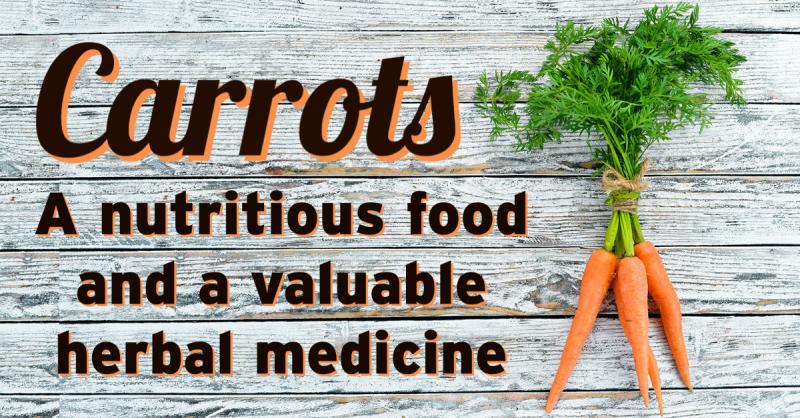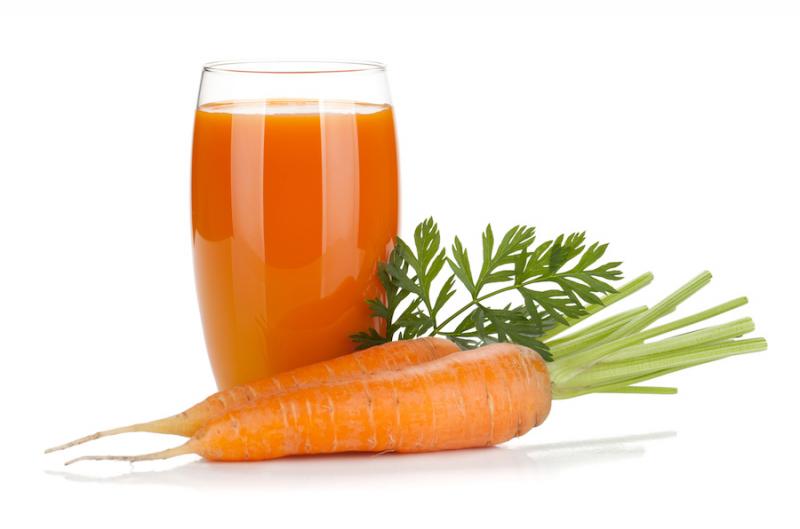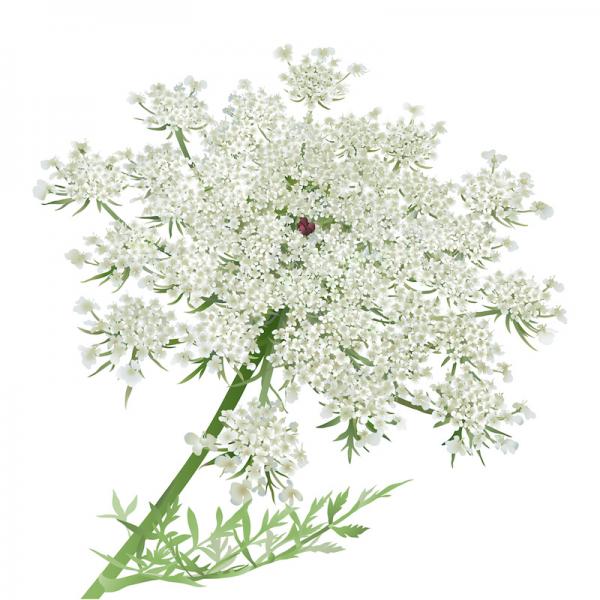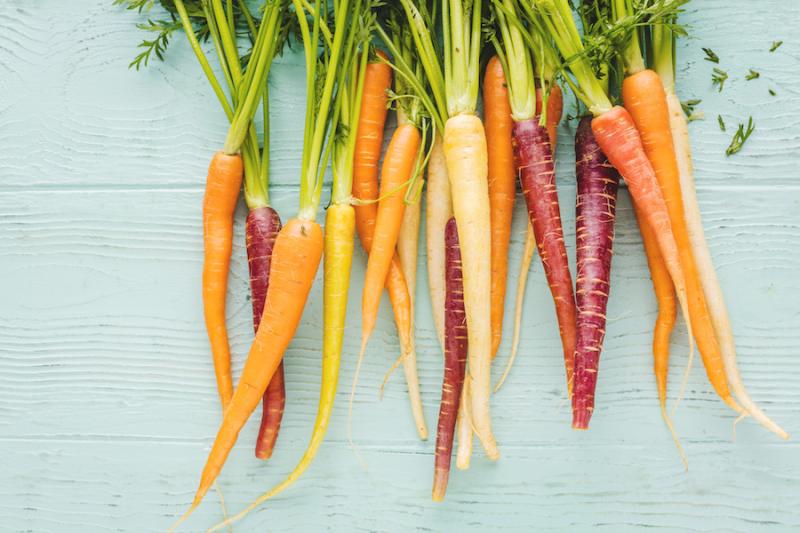
You are probably familiar with the famous saying of Hippocrates, “Let your food be your medicine and your medicine be your food.” When it comes to herbal medicine, there is no clear line where food ends and medicine begins; they exist on a continuum. On the food end, you get more structural and energy-producing nutrients, (fats, proteins, carbohydrates, and vitamins) and less phytochemicals. As you move to the medicinal side, you get more phytochemicals (e.g. tannins, alkaloids, essential oils) and lower caloric value.
Carrot is an interesting example of this continuum. Both the domesticated carrot and the wild carrot are the same species (Daucus carota) but they have different properties for health. The domesticated carrot has been bred to have a higher carbohydrate content, which makes it sweeter. The wild carrot, on the other hand, has more phytochemicals (essential oils, flavonoids, tannins, and an alkaloid called daucine), which makes it more medicinal.
Medicinal Use of Domesticated Carrots
 This doesn’t mean domesticated carrots don’t have medicinal use. They do. For example, raw carrot juice has long been promoted as a healing drink. Carrots are high in carotenoids, the plant precursors to vitamin A. Carotenoids get their name from carrots, and are valuable antioxidants. Vitamin A promotes eye health, which is why my mother always told me carrots were good for my eyes.
This doesn’t mean domesticated carrots don’t have medicinal use. They do. For example, raw carrot juice has long been promoted as a healing drink. Carrots are high in carotenoids, the plant precursors to vitamin A. Carotenoids get their name from carrots, and are valuable antioxidants. Vitamin A promotes eye health, which is why my mother always told me carrots were good for my eyes.
My first encounter with carrots as a healing medicine was in a class taught by a group of Utah midwives in the early 1980s. These women had successfully treated third-degree burns without scarring, using frequently changed, rotating applications of plantain oil, crushed fresh comfrey leaves mixed with honey, and poultices of freshly grated carrots, also mixed with honey. So, you can use grated carrots as a poultice to help heal dry, damaged, or irritated skin as well as burns.
 Wild Carrots as Medicine
Wild Carrots as Medicine
The wild carrot is commonly referred to as Queen Anne’s lace in herbal medicine because of the lacy flowers it produces. It grows wild in much of the eastern United States.
The seeds of Queen Anne’s lace contain a potent volatile oil, which is secreted via the kidneys causing a diuretic action. Juniper berries work the same way. Both juniper and Queen Anne’s lace are irritating diuretics, which means they provide a slight irritation to the kidneys to stimulate them to produce more urine. This also means they are contraindicated in kidney inflammation (nephritis).
The seeds of Queen Anne’s lace are indicated in conditions like edema, excess weight around the abdomen, kidney stones, water retention with backache, cystitis, and swollen feet. They may also be helpful for gout and arthritis.
Like many other seeds from plants in the parsley family (e.g. dill, caraway, coriander, anise, fennel), carrots seeds are used as a carminative and digestive stimulant.
Queen Anne’s Lace Flower Essence
 This brings us to the energetics of the carrot plant and the use of carrot as a flower essence. The carrot is a biennial, which means it lives for two years. During the first year, it develops a strong root and stores sugars and nutrients for the second year. We harvest carrots to eat during this first year, while they still possess all those sugars and nutrients.
This brings us to the energetics of the carrot plant and the use of carrot as a flower essence. The carrot is a biennial, which means it lives for two years. During the first year, it develops a strong root and stores sugars and nutrients for the second year. We harvest carrots to eat during this first year, while they still possess all those sugars and nutrients.
In the second year, the plant takes the stored energy and nutrients from the root and produces a compound umbel that is delicate and beautiful, hence the name Queen Anne’s lace. Out of these flowers come the seeds for the next generation.
Queen Anne’s lace flower essence addresses the issue of people whose actual physical eyesight and/or spiritual perception (also called psychic awareness) is distorted because they haven’t developed sufficient roots in life. They aren’t grounded enough, that is, connected to reality, to see or perceive clearly. This may be due to seeking to mentally escape the lower body functions (elimination and reproduction).
As a result, these people tend to project themselves into situations and lack objectivity in their perceptions. Queen Anne’s lace helps balance this upper and lower energy, helping a person’s spiritual perception and actual physical awareness to be more grounded in reality. This helps clear their vision. So, carrot not only helps the eyes, but it also helps the third eye or intuitive sense to be clearer because the person is more strongly connected with their physical and sexual instincts.
Carrot Seed Essential Oil
 Although I’ve never used it, carrot seeds can also yield an essential oil. Carrot seed oil is carminative and diuretic, like the seeds themselves. The oil is also used to help clear up skin conditions and promote greater skin health. The essential oil is also hepatic and is used to help regenerate the liver cells after hepatitis or poisoning.
Although I’ve never used it, carrot seeds can also yield an essential oil. Carrot seed oil is carminative and diuretic, like the seeds themselves. The oil is also used to help clear up skin conditions and promote greater skin health. The essential oil is also hepatic and is used to help regenerate the liver cells after hepatitis or poisoning.
Good quality carrots are probably also helpful for promoting liver health, which brings us back to the food-medicine continuum. I like to buy organic carrots because I find that they smell more carroty than non-organic carrots. I assume this means they not only have more essential oil in them but also more nutrients. I like it even better when I can grow my own carrots because the flavor and aroma of a freshly harvested garden carrot is much stronger than a carrot from the grocery store. Hence, the more wild or natural the carrot, the stronger its medicinal or healing properties.
 I also love to grow rainbow carrots, that is, carrots of all colors. I like to mix up a bunch of different varieties of carrots and plant them together. While the most popular carrots are orange, you can also get white, yellow, red, and purple-colored carrots. The different colors reflect different types of antioxidant compounds in the carrots, which is not only fun but very good for promoting health as well.
I also love to grow rainbow carrots, that is, carrots of all colors. I like to mix up a bunch of different varieties of carrots and plant them together. While the most popular carrots are orange, you can also get white, yellow, red, and purple-colored carrots. The different colors reflect different types of antioxidant compounds in the carrots, which is not only fun but very good for promoting health as well.
So, next time you spot some carrots at the grocery store, remember that they aren’t just useful as food. They’re also a potential medicine.
Steven's Articles
October
-

-
Understanding Caffeine & Cellular Adaptation
Preserving the power of caffeine's buzz and the…
September
-

-
Horseradish
A pungent spice for aiding protein metabolism…
-

-
Banaba or Crepe Myrtle
A beautiful tree from Southeast Asia whose leaves…
August
-

-
Monkeyflowers
Flower essences to help see ourselves more clearly…
-

-
Mariposa Lilies
Strengthening the bond between mother and child…
-

-
The Noble Bay Leaf
A common kitchen herb for aiding digestion and…
-

-
Epimedium: Horny Goat Weed
A circulatory stimulant and kidney yang tonic…
July
-

-
The Medicinal and Nutritional Benefits of Apricots
A nutritious fruit and valuable medicinal seed for coughs
-

-
Dogwoods
Asian dogwood is used to stop excessive discharge,…
June
-

-
Neem: The Village Pharmacy
A popular Ayurvedic remedy for dental and immune…
-

-
Spilanthes: The Toothache Plant
A traditional remedy for teeth and gums, as well…
-

-
Forsythia
An anti-inflammatory, fever-reducing, and infection fighting herb
May
-

-
Buckwheat (Kashi)
A delicious, high protein, gluten-free, gut-healthy food
-

-
Leaky Gut Syndrome
Plugging the leaks on the underlying cause of…
-

-
Storksbill
An edible, medicinal, weedy herb, helpful for…

